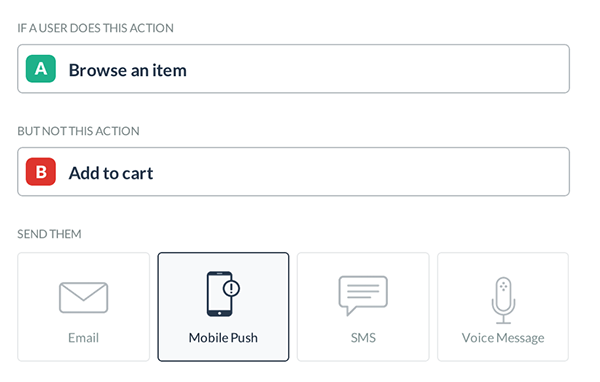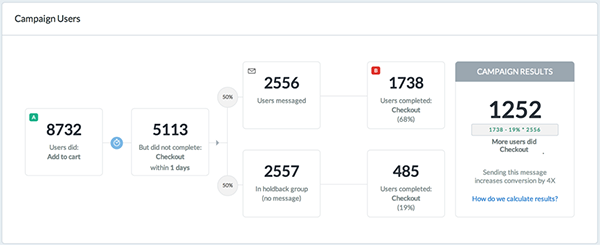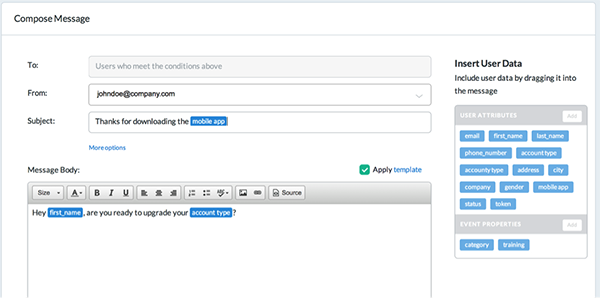Saas at Last for Messaging
For 15 years I ran technology product, design, and marketing teams, and every time I changed companies I had to build two things: a messaging platform and an A-B testing engine. Regardless of the vertical my company was attacking, we always needed messaging to get people to our site/app and either sign up, purchase, or re-engage, and we always needed a way to test and optimize the experience once we got people to the site. Optimizely took care of the A-B engine, and now with the launch of Subtraction Capital portfolio company Outbound, a simple tool that sends email, mobile push or SMS based messages, the messaging platform is taken care of as well.
First, Optimizely gave us A-B testing out of the box…
The first time I saw Optimizely was memorable for me. They were at Y Combinator and I was at Coupons.com, where I had just built an A-B testing engine for the fourth time. OK, the development team actually built it, not me (Manicka Babu and Gayathri Nayack if I remember that correctly), but that meant that some of our strongest developers had to wait to build some other Coupony thing until after they got the A-B engine done. Anyway, when I saw Optimizely pitch at a Y Combinator marketing tech event, I was so excited at the prospect of not having to ever do it again. I was hopeful that Dan Siroker and Pete Koomen would navigate the startup waters to success. First off, I would never have to build it again, and I could instead focus my company’s development resources on our core differentiating technologies. Much more strategic, right? Second, and equally important, there were always features that I wanted in my A-B testing engine that just did not make sense for me to build as a single company deriving benefit from the development work. The ROI just was not there for one company. But as an A-B testing engine for thousands of companies, Optimizely could cost effectively go very deep down the backlog. Their costs to develop on a platform instead of hacked onto a single code base would not be that much higher, but the return is effectively a small portion of the return from every company that benefits (assuming they can bill some small percentage of the value they create). Another way of looking at it is that each of the thousands of customers only has to pay a tiny fraction of the development cost, but the return does not change much, so the ROI is much better. Third, small companies that could not afford to build their own A-B testing engines yet could now access this game changing enabling technology because it was very simple to get started and give it a try.
Now, Outbound gives us event-based messages out of the box
OK, so from then forward, every company I worked at used Optimizely, and we could A-B test our interface and experience. Piece of cake! Which I suppose left us more time to build . . . a messaging platform. I remember when Facebook was early and not using email for re-engagement. I think the tech nerdiness of their core product team was resistant to using something as uncool and antiquated as email in a day when sms and smartphones were taking over. But eventually, the email summaries came around, and they were smart, customized, and conditional, only sending what was needed when it was needed. I saw this same progression at many of the great companies of Silicon Valley and realized that email was the dirty little re-engagement secret we were all too embarrassed to talk about in the open. Maybe it’s pathetic that an old, asynchronous, sparse interface channel created to copy snail mail was still ridiculously relevant. Like the famous Peter Thiel quote, “We wanted flying cars, instead we got 140 characters.” Maybe we just didn’t want to align ourselves anywhere near the spammers that annoy us with their abuse of this channel. But regardless, nearly every tech company I saw under the covers of found email their most successful and high ROI channel for customer acquisition as well as re-engagement, but no one was saying it out loud. Fast forward 5 or so years, and now we have email, sms, iOS system messages, and Android system messages all available as mainstream ways to reach the hook out and pull someone into an experience. But despite its ubiquity and effectiveness, we still have to go out and build our content creators, data warehouse, segmentation strategies, timing strategies, frequency strategies, chron jobs, etc to figure out what the right message is and when to deliver it. So when I first spoke to Josh Weissburg of Outbound.io a couple years ago from a Mark Harnett introduction, I felt that same light bulb as when I first saw Optimizely. Finally, someone was building the tool so that I did not have to build the messaging engine ever again. And not a moment too soon, with the proliferation of delivery mechanisms and interactive, it was getting harder and harder to build it yourself. In the early days, we had to worry about what people did on our web site, and what email message to send. And that is still a strong use case, but now most tech startups build interactive experiences on web sites as well as iOS and Android apps, and use all four of the channels I listed above as messaging channels. After a few interactions with Josh and co-founder Dhruv Mehta, I signed on as an advisor. In the year following, I joined Jason Portnoy at Subtraction Capital and have had the opportunity to become an investor at Outbound as well.
How Outbound works
Outbound lets a non-developer create and send messages. Often the product marketer is called upon to do this in larger companies, but in smaller companies that don’t have product marketing yet it could be the growth hacker, co-founder, product manager, designer, content marketer, copywriter or anyone who helps with distribution. No more developer required to create a new message or even the segmentation rules that trigger it. No more need to have 4 separate teams to develop and execute messaging on 4 separate channels. The point is that no matter who you are, you can use it. Setting up a campaign looks like this:

A favorite initial use case is the engagement funnel. Send this message via this channel when someone does A but does not do B, so for instance, when someone puts something in a shopping cart, but does not check out within 2 hours, send them a 10% off coupon to see if you can get them back to buy. Tracking can be wired once and the same wiring that makes tracking work is used for segmentation. Segmentationhappens on the fly – no need to pass in the segments, drag and drop them any time. Tracking and segmentation can happen across different interactive media types but be used together seamlessly. So in the above example, you could send the push just to users in San Francisco with premium accounts. All the hard things are taken care of leaving the content creator to focus on getting people from point A to point B in your product:

What’s so special about this tool?
To continue the Optimizely parallel from above, here’s a review of the three benefits from finally getting this important function into the Saas realm. First, I never have to build it again. Check. Well, I am not an operator anymore, so this is leveraged way beyond that now. This will save dozens of companies having to build a sophisticated messaging platform as I can just refer Subtraction Capital companies in. Second, Outbound can build the deep functions that would never make sense for a single company. Well, definitely for content and rule creation, Outbound already has a much simpler interface that allows marketers to create and send triggered messages than any company I have ever seen. For example, how many times does a non-technical person want to customize a message but doesn’t want to bug engineering to figure out how? In Outbound, they don’t need to hunt for that variable and figure out a templating language for variables–just drag the data in from a menu right next to the editor:

And previously, as companies grew, they would often pick a main channel and take it on first. Later, they might add a second channel, for instance sending system messages to mobile app users or email messages to web site users. The marketers would of course want to test things like sending system message vs web site message but these were usually separate systems and the coordination alone would be too big a headache, much less testing strategies like following a system message with an email 3 hours later. So Outbound already covers some of the most important of these cases with their beta product, and will surely get much deeper by the time they are at official non-beta “launch product.” A personal favorite pet of mine will of course be the A-B testing access : ) Third, Outbound makes the benefits of solid messaging programs available to a broader group of tech startups instead of just the big dogs. Before Outbound, every company wanted the benefits of a really intelligent, well thought out, well created messaging program, but it was just too darned expensive. The answer it seemed was either to blast away, sending less relevance and adding to the spammy feel of our inbox that make even shameless marketers wince about using this channel, or stay silent like Facebook did until we are big enough to build a solid messaging platform. Outbound checks this box as well. I am excited to see Outbound.io go out into the world now. And I am anxious to see what all my distribution friends (growth hackers, marketers, product managers, designers, copy writers, etc) come up with as use cases to help their companies grow. And most of all I am glad that there is one more tool I never have to build again. Software is eating the world cheaper and cheaper, and faster and faster, and it is because of tools like this. At the end of the day, helping push that rock is the most exciting part of all.
-
kmenendez
-
kmenendez
-
https://webgeekrants.blogspot.com Paul Willard
-
-
rociovillalobos
-
https://webgeekrants.blogspot.com Paul Willard
-
-
Kattya Breitenbach
-
https://webgeekrants.blogspot.com Paul Willard
-
Kattya Breitenbach
-
-